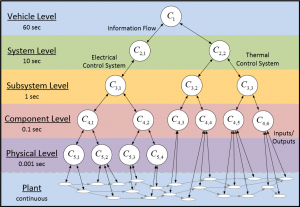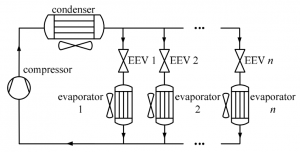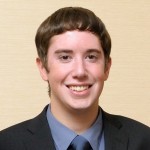
- Curriculum Vitae
- koeln2@illinois.edu
- Ph.D. – University of Illinois Urbana-Champaign, 2016
- M.S. – University of Illinois Urbana-Champaign, 2013
- B.S. – Utah State University, 2011
- Research Interests: Hierarchical Control, Model predictive control, Aircraft electro-thermal systems, Multi-evaporator vapor compression systems, Extremum seeking control
- Career goal: To lead cutting-edge research in the field of advanced controls at a top research university
I am currently seeking employment as an Assistant Professor in Mechanical Engineering at one of our nation’s top research universities. I am a NSF GRFP fellow and recent finished my PhD in Mechanical Science and Engineering at the University of Illinois at Urbana-Champaign. Working with Professor Andrew Alleyne, my research is in the field of dynamics and control systems with a focus on advanced control strategies for electro-thermal systems.
My early career goals concentrate on advancing the capability and efficiency of complex energy systems through dynamic modeling and control. By developing advanced control techniques, I plan to enable greater power density in high power electronics, more efficient operation of on- and off-road vehicles, and higher power onboard military and commercial aircraft. Through collaborations, my work will impact the broad application areas of both electrical and thermal systems and provide theoretical contributions to the field of model-based control of complex systems. My long term goal is to establish a cohesive, diverse, and prolific research group centered on the development of the advanced model-based control techniques required to overcome the power limitations and improve the efficiency of today’s high-performance energy systems.
I am also eager to bring an electrical and thermal systems perspective to the classroom. I have successfully taught undergraduate heat transfer (UIUC’s ME 320) and was recognized on the “List of Teachers Ranked as Excellent by Their Students.” In the future, I plan to teach additional courses in dynamics and controls with a balance of theory and application at the undergraduate and graduate levels.
For additional information, please see my Research and Teaching Statements and contact me at the email address provided above. Highlights from my Master’s and PhD research are provided below along with links to relevant publications.
This research is sponsored by the National Science Foundation (NSF) Graduate Research Fellowship Program (GRFP), the Air Force Research Laboratory (AFRL), and the National Science Foundation Engineering Research Center for Power Optimization of Electro-Thermal Systems (POETS) agreement EEC-1449548.
Ongoing Work
Hierarchical Control of Electro-Thermal Systems
Modern vehicles are a heterogeneous mix of complex interconnected systems of various energy domains. Enhanced optimization of power generation, distribution, storage, and utilization can be achieved using dynamic model-based control to improve performance and efficiency, while preventing thermal runaway. My current research efforts include the development of a hierarchical model-based control architecture. The goal of this ongoing research is to use knowledge of the system dynamics, along with knowledge of upcoming events and disturbances, to develop a hierarchical control framework capable of doubling the power density of existing electro-thermal systems, without changes to the physical system.
The primary objective is the development and evaluation of a model predictive control (MPC) based hierarchical control strategy specifically designed to optimize the power flow throughout the systems and subsystems of vehicles over multiple timescales. While the focus of this work is on the interaction of thermal and electrical systems in aircraft, the hierarchical framework under development will be:
- widely applicable to heterogeneous power flow systems of various energy domains, architectures, and components,
- scalable to large systems with many actuators, states, measurements, and control objectives,
- robust to model and signal uncertainty,
- high performance, via fast transient response, efficient operation, and constraint satisfaction, and
- computationally efficient for reduced computational cost and faster control decisions.
Fig. 1 shows a notional hierarchical control framework used to demonstrate the key features of the approach. The structure of the control hierarchy is designed to match the underlying structure of the system. Each controller utilizes a dynamic model of a corresponding section of the overall systems where lower level controllers use high fidelity models of single components or subsystems while upper level controller use lower fidelity models of entire systems or the vehicle. Additionally, lower level controllers make control decisions on a fast update rate in order to provide fast response times and disturbance rejection, while the upper level controllers make control decisions on a slow update rate in order to allow these controllers to preview far into the future to better prepare the system for upcoming tasks and known disturbances. Coordination between various subsystems and timescales is achieved through top-down and bottom-up communication between these controllers, allowing global, system-wide, objectives to be met utilizing distributed decision making.
Previous Work
Multi-evaporator Vapor Compression Systems
Multi-evaporator vapor compression systems (ME-VCSs) are becoming widely used to meet the cooling needs for multiple thermal loads via a single system (Fig. 2). As the number of evaporators increases, the size of these systems can make a centralized control approach impractical and computationally expensive; thus, motivating a decentralized control design. Linear gray-box modeling techniques show that ME-VCSs have a distinct underlying structure between the actuators and dynamic states known as a block arrow structure (BAS) (Fig. 3). This structure captures the high degree of coupling found in ME- VCSs, which can lead to poor decentralized control performance. This work develops a partially decentralized model predictive control strategy which directly considers the coupling in the system when making control decisions by exploiting the BAS. The gray-box modeling approach and the decentralized nature of this BAS control strategy prove scalable to n-evaporator systems. Through simulated case studies, it is shown that this BAS control strategy can approximate the performance of a centralized control approach for ME-VCSs while significantly reducing computational costs (Figs. 4 and 5).
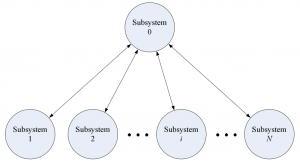
Fig. 3 – Subsystem interaction diagram for BAS systems where Subsystem 0 represents the compressor and condenser and the Subsystems 1 through N represent the N expansion values and evaporators.

Fig. 4 – Simulated air temperature regulation under centralized and BAS control showing the BAS approach has nearly the same control performance as the centralized control approach, despite the partially decentralized nature of the BAS control strategy.

Fig. 5 – Controller computation time as a function of the number of evaporators in the system for the centralized and BAS controllers. With 30 evaporators, the BAS approach requires less than 1% of the centralized controller computation time.
Optimal Subcooling and Extremum Seeking Control
With vapor compression systems consuming a significant portion of the overall U.S. energy consumption each year, extensive efforts have been made toward the development of control strategies which aim to maximize system efficiency while providing the desired cooling. However, previous control strategies under-utilize a degree of freedom corresponding to the amount of refrigerant in the system, which is related to condenser subcooling and can significantly affect system efficiency. In this work, an alternative system architecture (Fig. 6), which utilizes a receiver and an additional electronic expansion valve, is used to provide independent control of condenser subcooling. Simulation and experimental results show there exists an optimal subcooling which maximizes system efficiency; however, this optimal subcooling changes with operating conditions (Fig. 7). Therefore, extremum seeking control is implemented to find the optimal subcooling in an adaptive, model-free manner. Experimental results demonstrate a 9% increase in efficiency using the alternative architecture and extremum seeking control (Fig. 8).
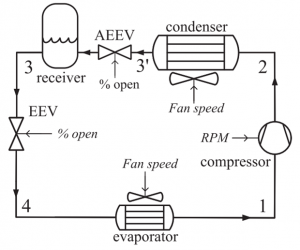
Fig. 6 – Alternative system architecture with an additional electronic expansion value between the condenser and the receiver for control of condenser subcooling.
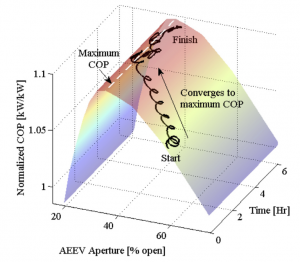
Fig. 8 – Experimental results showing the AEEV aperture converging to the optimal aperture (corresponding to the optimal subcooling), resulting in a 9% increase in COP.
Relevant Publications (Book Chapter)
- Koeln, Justin; Keating, Bryan; Alleyne, Andrew; Price, Christopher; Rasmussen, Bryan, “HVAC System Modeling and Control: Multi-zone Temperature Modeling and Control,” Intelligent Building Control Systems, John Wen and Sandipan Mishra (ed.), Springer. (Under Review)
- Rasmussen, Bryan; Price, Christopher; Koeln, Justin; Keating, Bryan; Alleyne, Andrew, “HVAC System Modeling and Control: Vapor Compression System Modeling and Control,” Intelligent Building Control Systems, John Wen and Sandipan Mishra (ed.), Springer. (Under Review)
Relevant Publications (Journal)
- Koeln, Justin; Alleyne, Andrew, “Robust Hierarchical Model Predictive Control of Graph-based Power Flow Systems,” Automatica, 2016. (Submitted)
- Koeln, Justin; Alleyne, Andrew, “Stability of Decentralized Model Predictive Control of Graph-based Power Flow Systems via Passivity,” Automatica, 2016. (Accepted)
- Williams, Matthew; Koeln, Justin; Pangborn, Herschel; Alleyne, Andrew, “Dynamical Graph Models of Aircraft Electrical, Thermal, and Turbomachinery Components,” Journal of Dynamic Systems, Measurement, and Control, 2016. (Submitted)
- Koeln, Justin; Alleyne, Andrew, “Optimal Subcooling in Vapor Compression Systems via Extremum Seeking Control: Theory and Experiments,” International Journal of Refrigeration, 2014. (PDF)
- Jain, Neera; Koeln, Justin; Sundaram, Shreyas; Alleyne, Andrew, “Partially-Decentralized Control of Large-Scale Variable-Refrigerant-Flow Systems in Buildings,” Journal of Process Control, 2014. (PDF)
- McCarthy, Kevin; McCarthy, Patrick; Wu, Ning; Alleyne, Andrew; Koeln, Justin; Patnaik, Soumya; Emo, Stephen; Cory, Joshua, “Model Accuracy of Variable Fidelity Vapor Cycle System Simulations,” SAE Technical Paper, 2014. (PDF)
Relevant Publications (Conference)
- Pangborn, Herschel; Williams, Matthew; Koeln, Justin; Alleyne, Andrew, “Graph-Based Hierarchical Control of Thermal Fluid Power Flow Systems,” Proc. of the 2017 American Control Conference, 2017. (Accepted)
- Koeln, Justin; Williams, Matthew; Herschel, Pangborn; Alleyne, Andrew, “Experimental Validation of Graph-based Modeling For Thermal Fluid Power Flow Systems,” Proc. of the ASME Dynamic Systems and Control Conference, 2016. (PDF)
- Koeln, Justin; Alleyne, Andrew. “Event-based Hierarchical Control of Power Flow in Vehicle Systems,” Proc. of the 2016 American Control Conference, 2016. (PDF)
- Koeln, Justin; Williams, Matthew; Alleyne, Andrew. “Hierarchical Control of Multi-domain Power Flow in Mobile Systems – Part I: Framework Development and Demonstration,” Proc. of the ASME Dynamic Systems and Control Conference, 2015. (PDF)
- Williams, Matthew; Koeln, Justin; Alleyne, Andrew. “Hierarchical Control of Multi-domain Power Flow in Mobile Systems – Part II: Aircraft Application,” Proc. of the ASME Dynamic Systems and Control Conference, 2015. (PDF)
- Keating, Bryan; Koeln, Justin; Alleyne, Andrew. “Weiner Modeling of a Closed Loop Vapor Compression System for Extremum Seeking Controller Design,” Proc. of the ASME Dynamic Systems and Control Conference, 2015. (PDF)
- Koeln, Justin; Alleyne, Andrew. “Scalable Model Predictive Control for Multi-Evaporator Vapor Compression Systems,” Proc. of the 2014 American Control Conference, 2014. (PDF)
- Koeln, Justin; Alleyne, Andrew, “Optimal Subcooling in Vapor Compression Systems via Extremum Seeking Control,” Proc. of the 6th ASME Dynamic Systems and Control Conference, 2013. (PDF)
- Koeln, Justin; Alleyne, Andrew, “Decentralized Controller Analysis and Design for Multi-Evaporator Vapor Compression Systems,” Proc. of the 2013 American Control Conference, 2013. (PDF)
- Koeln, Justin; Kania, Megan; Jain, Neera; Alleyne, Andrew, “Experimental Load Emulation for Multi-Evaporator Air Conditioning and Refrigeration Systems,” Proc. of the International Refrigeration and Air Conditioning Conference at Purdue, 2012. (PDF)
- Kania, Megan; Koeln, Justin; Alleyne, Andrew; McCarthy, Kevin; Wu, Ning; Patnaik; Soumya, “A Dynamic Modeling Toolbox for Air Vehicle Vapor Cycle Systems,” SAE Technical Paper, 2012. (PDF)
Relevant Publications (Thesis)
- Koeln, Justin, “Hierarchical Power Management in Vehicle Systems,” Ph.D. Dissertation, Dept. Mech. Eng., Univ. Illinois Urbana-Champaign, Urbana, IL., 2016. (PDF)
- Koeln, Justin, “A Decentralized Control Design Approach to a Class of Large-Scale Systems,” M.S. Thesis, Dept. Mech. Eng., Univ. Illinois Urbana-Champaign, Urbana, IL., 2013. (PDF)
